699 Search Results for communication book
September 20, 2018
by Carole Zangari -
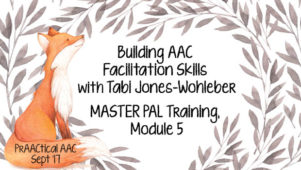
Our AAC Training Series continues today and we are incredibly grateful to Tabi Jones-Wohleber for sharing these presentation materials with us. Today’s training materials center on a topic that is near and dear to my prAACtical heart: Using statements more often than questions. The instructional time for Module 5 is about 90-120 minutes which allows time for discussion and practice. ::::::::::::::::::::::::::::::::::::::::::::::::::::::::::::::::::::::::::::::::::::::::::::::::::::::::::::: Model as a MASTER PAL Module 5: Statements More Than Questions Facilitator Guidelines STATEMENTS MORE THAN QUESTIONS Questions are necessary to help us learn about the things, people, and activities in our environment and beyond. However, interactions heavily weighted with questions do not often yield the quality exchanges required to build relationships, gain understanding, foster autonomous communication or facilitate initiation. This module explores the power of statements (aka nondirective language and descriptive teaching) in shaping meaningful engagement for learning and socially interacting. It includes interactive activities, video links, lots... [Read More...]
September 17, 2018
by Carole Zangari -
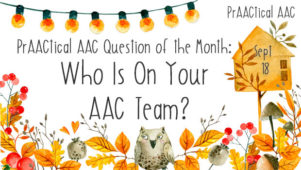
Once a month we like to turn the tables and see how PrAACtical AAC readers respond to a quick question. Our first AAC Question of the Month asked: What AAC skill is your biggest strength? Here’s how readers weighed in. Aided language input 38.1% Coaching communication partners 9.5% Assessment 8.3% Creating visual supports 7.1% Programming SGDs/AAC apps 6% Teaching early communicative functions 6% None, I don’t feel strong in any of these areas. 4.8% Collaborating with other service providers 3.6% Supporting AAC families 3.6% Report-writing and documentation 2.4% Supporting eye gaze users 2.4% Signing 1.2% PECS 1.2% Today, we turn our attention to AAC teams and who is one them. In the textbook, there are lots of disciplines listed but there is probably wide variability in which ones actually participate in AAC teams in different parts of the world. Take a minute, if you can, to tell us which... [Read More...]
September 13, 2018
by Carole Zangari -
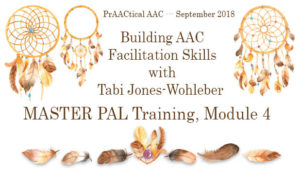
Ready for more AAC training materials? In today’s post, Tabi Jones-Wohleber is sharing another module in the MASTER PAL series. This 30-minute session focuses on the role of multiple modalities in AAC. :::::::::::::::::::::::::::::::::::::::::::::::::::::::::::::::::::::::::::::::::::::::::::::::::::: Model as a MASTER PAL Module 4: Accept Multiple Modalities Facilitator Guidelines We all use multiple modalities to communicate…speech, text, email, a gesture, facial expressions. In much the same way we encourage young children to interact by assigning meaning to their gestures, expressions, and utterances, responding meaningfully to the communicative attempts of those who use AAC validates and encourages the effort. Honor all modalities and respond by modeling AAC as much as possible(regardless of the modality used by the PWUAAC) teaches AAC. Seize the opportunity to teach and expand language. After all, multi-modal communication shapes the human experience. For this training you will need: The Presentation Slides The Presentation Handout The Facilitator’s Guide Warm-up Discussion: Thinking Prompt... [Read More...]
September 6, 2018
by Carole Zangari -
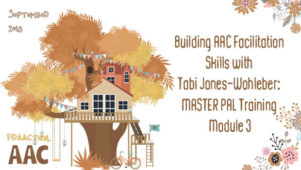
Our training series continues with West Virginia-based SLP Tabi Jones-Wohleber, who works with the AT Team for Frederick County Public Schools in Maryland and provides services to infants and toddlers in the West Virginia Birth to Three programs. In the first two posts, Tabi shared the Overview and Modeling modules and their accompanying resources. In today’s post, the training focuses on an important topic, motivation. ::::::::::::::::::::::::::::::::::::::::::::::::::::::::::::::::::::::::::::::::::::::::::::::::::::::::: Model as a MASTER PAL Module 3: Motivate Facilitator Guidelines Genuine motivation goes well beyond gummies and goldfish; reinforcers are only one small part of the picture as we endeavor to understand what truly drives an individual’s desire to learn and communicate. So much of the time it is the quality of the relationship and the meaningfulness of the interaction. This module discusses the importance of motivation in learning and engaging, whether intrinsic or extrinsic, as well as the undesirable consequences that occur when lack of motivation... [Read More...]
August 27, 2018
by Carole Zangari -
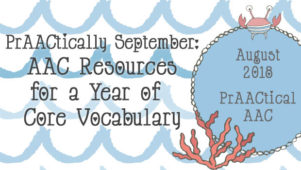
Are you supporting AAC learners who have SGDs or communication boards/books with high-frequency words? If so, join us as we work to model, practice, and teach these words throughout the day. It can feel overwhelming, so we tend to focus on a subset of words each month. The Year of Core Vocabulary approach isn’t a developmental list of words to be introduced in a specific order, but rather a way of gradually exposing learners to more and more words over time. We do that by modeling them on their device or communication aid when we talk, and plan specific instructional activities to teach word meanings, play games to help them better recognize and understand the symbols for those words, and, elicit them frequently from those who are just learning their AAC systems. Our AAC friends need practice, practice, and more practice. Over time, they will gain more fluency and automaticity with the words in their AAC... [Read More...]
August 19, 2018
by Carole Zangari -
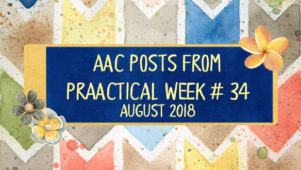
Busy week, AAC friends? Here are some posts that you may have missed. Monday – PrAACtical Resources: Core Vocabulary Flipbook for August Words Tuesday – AAC Link Up Wednesday – Video of the Week: Achieving Authentic Communication Thursday – Throwback Thursday: AAC Resources for Supporting Teams ::::::::::::::::::::::::::::::::::::::::::::::::::::::::::::::::::::::::::::::::::::::::::::::::::::: Still hungry for some AAC reading? Visual Supports for Places Around School (downloadable) Visual Supports for Places We Go (downloadable) AAC Intervention for Children with ASD Teaching Communication Partners Through Video Self-modeling Bilingual AAC Assessment Tips
July 23, 2018
by Carole Zangari -
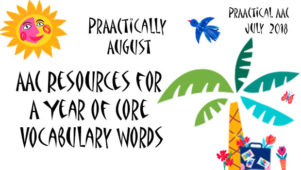
The summer is zooming by here in Florida and lots of professionals and families are starting to think about heading back to school. Teachers, therapists, and aides play a pivotal role in helping AAC learners develop skills with core vocabulary so that they have a body of words that can be used across activities, environments, and communication partners. There are lots of ‘right’ ways to support these students. Among them is an instructional approach in which a new set of core words is introduced every few weeks in order to build their experiences with AAC. Our Year of Core Words materials has two versions, Set 1 (12 words/month) and Set 2 (16 words/month; Different than the previous year’s core words). If you’ve been following along, or are just getting started, these resources may be of interest. Set 1 Words: any, bring, day, fall, give, hot, job, know, other, sick, sorry, together Set 2 Words: aide,... [Read More...]
July 12, 2018
by Carole Zangari -
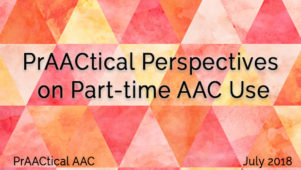
Can AAC be of benefit to people who speak? Today, we welcome Alyssa Hillary Zisk, an Autistic PhD student in the Interdisciplinary Neuroscience Program at the University of Rhode Island, who shares their experiences with part-time AAC use. :::::::::::::::::::::::::::::::::::::::::::::::::::::::::::: Think about a person who uses AAC. I’m probably not the person you thought of. For one thing, I’m an autistic adult, and the AAC research I’ve seen relating to autism is generally about kids. Services are generally aimed at kids too. For another, my AAC use isn’t the result of having consulted with a specialist who evaluated me and suggested possible strategies. Oh, and my speech sounds pretty fluent, in two languages — when I can talk. That’s not always, and there is the reason I use AAC. I’ve always had somewhat intermittent speech – that is, I can talk, but only sometimes. For this reason, I use a variety of... [Read More...]
July 8, 2018
by Carole Zangari -
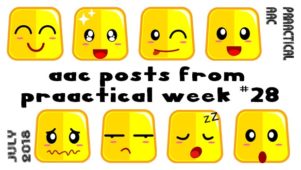
Happy Sunday, AAC friends. Here are some posts you may have missed. Monday – PrAACtical Resources: Core Vocabulary Flipbook for July Words Tuesday – AAC Link Up Wednesday – Independence Day, AAC style! Thursday – 5 Visual Supports for Emotions and Feelings ::::::::::::::::::::::::::::::::::::::::::::::::::::::::::::::::::::::::::::::::: Looking for a couple of additional posts to explore? Check out these selections fromt the archives. PrAACtical Suggestions: How to Get Started with a New AAC Client Visual Schedules 411 How to Use Magnets to Promote Language Development Visual Supports for Places We Go (downloadable template) From Disney Princesses to Houseplants: More on Building Communication Opportunities
June 28, 2018
by Carole Zangari -
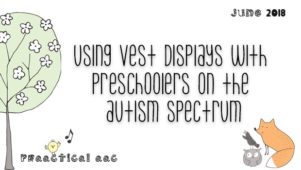
We’re so pleased to welcome back Dr. Carol Goossens’, an AAC pioneer who is an internationally-recognized consultant, SLP, and Special Educator from New York. Throughout her career, she has consulted extensively in a variety of classrooms serving the full spectrum of children with special needs. Dr. Goossens’ has presented both nationally and internationally about her collaborative work with teachers, therapists, and families. In today’s post, she shares a treasure trove of ideas on using wearable AAC. Learn more about her approach to using vest displays in this extensive post. :::::::::::::::::::::::::::::::::::::::::::::::::::::::::::::::::: Using Vest Displays with Preschoolers on the Autism Spectrum When working with students on the spectrum, we often struggle to gain and maintain their attention, especially during group activities such as Circle Time/Morning Meeting. The songs offered during Circle Time, however, create a great forum for working on a variety of communication skills, e.g., claiming a turn, announcing a song, choosing... [Read More...]









